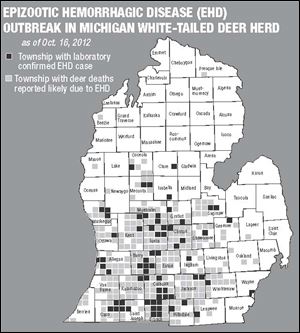 Dear Readers,
Dear Readers,
We are making our way towards our funding goal of $40,000 by December 31, 2012. To date we have received over $850 in individual donations. A BIG shout out of appreciation to those who have shown your support for the Wildlife Disease News Digest!
In addition to donations, a number of individuals have contributed great funding ideas, which we are pursuing. Many thanks to you! Along with their ideas (please keep them coming!), readers have also sent in some good questions that we felt others might share an interest in.
1) Will you be offering institutional subscriptions options?
Yes, we have a process to accept subscriptions from institutions who are interested in supporting a resource that their wildlife health staff have come to rely on for wildlife disease developments and news.
Please have your institution/organization to contact us at wdin@wdin.org so we can begin the subscription process.
2) Instead of submitting my donation online, can I mail it?
Yes, you can find a printable gift form on the University of Wisconsin Foundation website or download a gift form here.
3) What happens to the donations if WDIN does not make its funding goal?
All funds will be used to keep the Digest going. In meantime, our strategic planning committee continues to explore and pursue many funding opportunities.
Do you find yourself frequently forwarding interesting stories or articles you find on the Digest to friends and colleagues? Or do you find articles/references that you would not readily discover elsewhere? Consider showing your support today with a donation or asking your organization to sponsor the Digest.
![]() Keep this channel of wildlife disease information open for everyone's benefit! Donate today!
Keep this channel of wildlife disease information open for everyone's benefit! Donate today!
Cris Marsh
Megan Hines
Vicki Szewczyk
Dr. Kurt Sladky
TOP STORIES
Hurricane Sandy Aftermath: What Happens to the Birds?
 |
| Rough surf breaks over the storm-battered dunes of Cape May, New Jersey, on October 29. Photograph by Mel Evans, AP |
We talked to Bryan Watts, director of the Center for Conservation Biology in Williamsburg, Virginia, to get a bird's-eye perspective on the disaster....
Are you worried about birds dying?
We have mortality events with these hurricanes, [especially with] birds that are either migrating or in vulnerable situations. Although surprisingly we have tracked several whimbrels with satellite transmitters that have flown directly through these storms. Last fall, we tracked a whimbrel named Chinquapin right into Hurricane Irene that successfully [landed] in the Bahamas.
Local birds tested for neurologic disease
Remember the birds we showed you last week, being treated for feeling the effects of red tide in Southwest Florida? Monday, the state went to Sanibel Island to test the birds.
They want to make sure the birds aren't suffering from a devastating neurologic disease called the Newcastle Disease Virus - or NDV. Both NDV and red tide toxin show similar symptoms.
So FWC's Dan Wolf and CROW Director Dr. Heather Barron teamed up to study nearly 20 double-crested cormorants."More than likely, it's red tide. But we can never be sure and if we have a bird with neurologic signs it would be wrong not to test these," Wolf said.
Most recently in Florida, the disease turned up two years ago in birds near Tampa and St. Petersburg.
Long-billed vulture numbers recover in Pakistan after diclofenac ban
...Populations of the critically endangered long-billed vulture (Gyps indicus) in Pakistan are beginning to recover after the ban of diclofenac, a veterinary drug that is toxic to vultures, a new study shows.
...However a new study by the Peregrine Fund found that by 2008, two years after the ban, breeding populations of the long-billed vulture at study sites in Pakistan had increased by up to 52%.
 Reported Wildlife Mortality Events to the USGS National Wildlife Health Center Updated
Reported Wildlife Mortality Events to the USGS National Wildlife Health Center UpdatedUSGS and a network of partners across the country work on documenting wildlife mortality events in order to provide timely and accurate information on locations, species and causes of death.
This information was updated on October 26, 2012 on the USGS National Wildlife Health Center web page, New and Ongoing Wildlife Mortality Events Nationwide.
Quarterly Mortality Reports are also available from this page. These reports go back to 1995.
26 Oct 2012
Location:USA
OTHER WILDLIFE HEALTH RELATED NEWS
- Researching Deer Hair Loss Syndrome [CDFG Wildlife Investigation Lab blog]
- CCWHC Graduate Student Researches Parasites of Free-Ranging Lemurs in Madagascar [CCWHC healthywildlife.ca blog]
- Clock Is Ticking On Plum Island Preservation [Infectious disease research facility]
- Honeybees Harbor Antibiotic-Resistance Genes
- White-nose syndrome kills 5.5 million bats in U.S., Canada
 |
| Map of EHD outbreak in Michigan |
- ‘Bird deaths? Inform nearest vets’ [Mysore, India]
- Migratory birds suspects in flu outbreak [India]
- Bird Infected with West Nile Virus Found in San Rafael [Marin Co., California, USA - Map It
 ]
] - Dead Crow Tests Positive For West Nile Virus [La Jolla, California, USA - Map It
 ]
]
- EHD kills off record number of Mich. white-tail deer in ’12 [See map on right][Michigan, USA]
- Deer disease turns up in Buncombe [Buncombe Co., North Carolina - Map It
 ]
]
- Chronic Wasting Disease Takes Toll on Taxidermists
- Doe escapes chronic wasting disease quarantined pen [Pennsylvania, USA]
- Pennsylvania's chronic wasting disease quarantine list grows to 12 deer farms
- Deer disease worries Ind. officials [Indiana, USA]
- Canary in a data mine: How analytics detects early signs of bio threats
- Viral research faces clampdown: US biosecurity concerns could harm collaboration [Nature News]
- Increases Funding to Combat Influenza and Emerging Disease Threats
- Medical and veterinary scientists fight infectious diseases [Kenya, Africa]
Courtesy of a fellow Digest reader






No comments:
Post a Comment